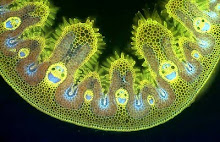Hellebores are popular garden plants because they flower so early in the year. The so-called Lenten rose (Helleborus orientalis and its many hybrids that are grouped together as H. x hybridus) - above - flowers in March in British gardens and H.niger a.k.a. the Christmas rose (below) flowers even earlier, though never earlier than February in my Durham garden. Both are also popular with the first bumblebees to emerge from hibernation, thanks to a peculiarity of their floral architecture.
Hellebore flowers are deceptive because those petals are not petals at all - they're the sepals that protected the bud before the flower opened, that then expand and assume a petal-like advertising function when the plant blooms. The real petals are converted into a ring of green, tube-like structures with nectar-secreting tissue inside.
Once the flower opens these tubular petals fill with nectar and become a favoured refuelling station for bumblebees. The stamens, as you can see in the photo above, burst open a few at a time, and the nectaries keep filling with nectar until all the pollen has been released and the stigmas - in the centre of the flower - have been pollinated. True petals usually fall from a flower once it has been fertilised and seeds begin to set, but the sepals of hellebores remain and become green, photosynthesising and providing resources for the developing seeds...... as in the bottom left illustration below.
Illustration source: Prof. Dr. Otto Wilhelm Thomé ''Flora von Deutschland, Österreich und der Schweiz'' 1885. http://en.wikipedia.org/wiki/File:Illustration_Helleborus_niger0.jpg
Once the seeds ripen and are shed, a further unusual feature becomes apparent...

..... because each seed has a small white body called an elaiosome attached to the seed coat that's attractive to ants, which carry the seeds away from the parent plant. The seeds have a natural dormancy that takes a cycle of winter chilling to break, before they will germinate. You can find an excellent web site devoted to this plant genus at http://www.hellebores.org/index.html
































